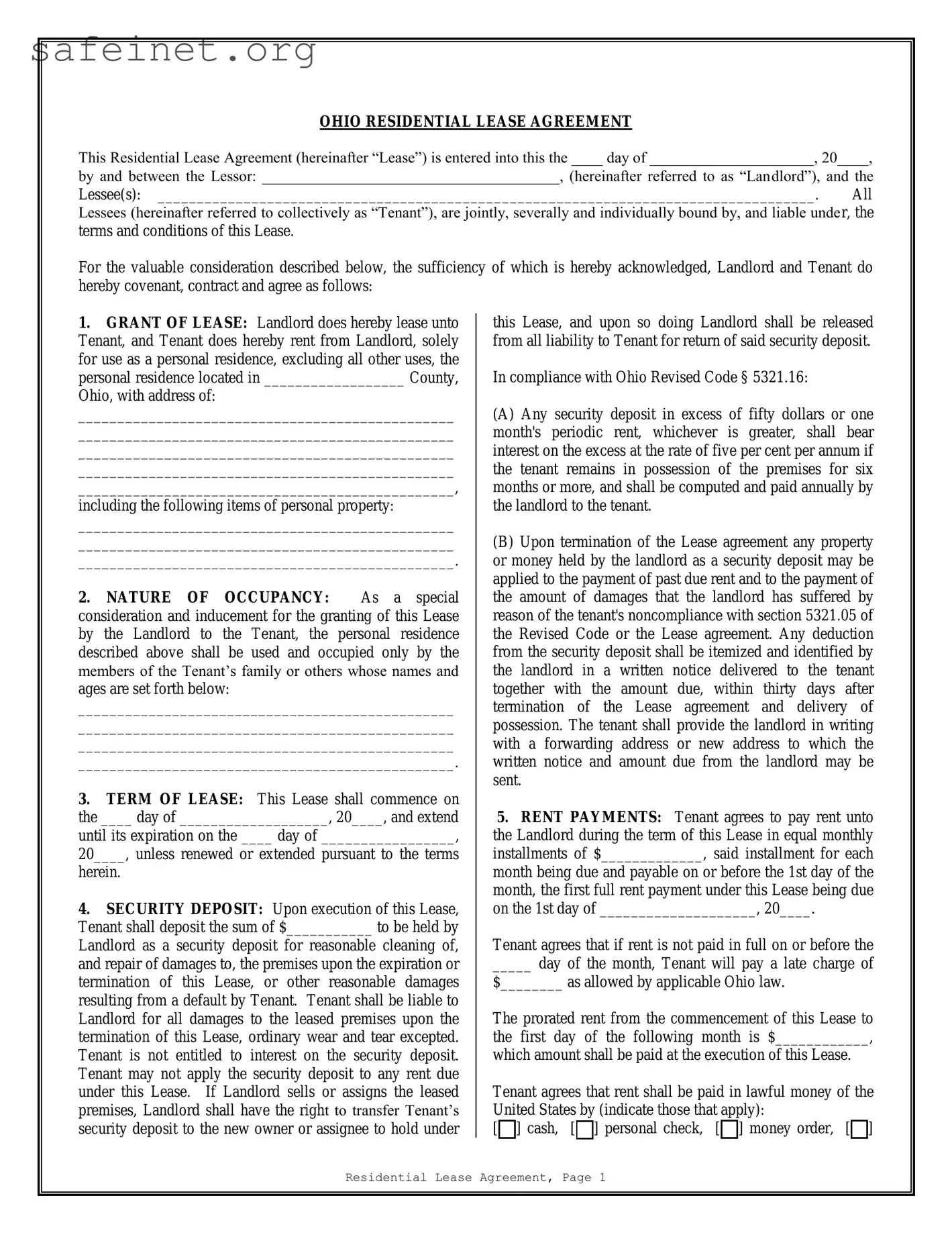OHIO RESIDENTIAL LEASE AGREEMENT
This Residential Lease Agreement (hereinafter “Lease”) is entered into this the ____ day of _____________________, 20____,
by and between the Lessor: ______________________________________, (hereinafter referred to as “Landlord”), and the
Lessee(s): ____________________________________________________________________________________. All
Lessees (hereinafter referred to collectively as “Tenant”), are jointly, severally and individually bound by, and liable under, the terms and conditions of this Lease.
For the valuable consideration described below, the sufficiency of which is hereby acknowledged, Landlord and Tenant do hereby covenant, contract and agree as follows:
1.GRANT OF LEASE: Landlord does hereby lease unto Tenant, and Tenant does hereby rent from Landlord, solely for use as a personal residence, excluding all other uses, the personal residence located in __________________ County, Ohio, with address of:
________________________________________________
________________________________________________
________________________________________________
________________________________________________
________________________________________________, including the following items of personal property:
________________________________________________
________________________________________________
________________________________________________.
2.NATURE OF OCCUPANCY: As a special consideration and inducement for the granting of this Lease by the Landlord to the Tenant, the personal residence described above shall be used and occupied only by the members of the Tenant’s family or others whose names and ages are set forth below:
________________________________________________
________________________________________________
________________________________________________
________________________________________________.
3.TERM OF LEASE: This Lease shall commence on the ____ day of ___________________, 20____, and extend until its expiration on the ____ day of _________________, 20____, unless renewed or extended pursuant to the terms herein.
4.SECURITY DEPOSIT: Upon execution of this Lease, Tenant shall deposit the sum of $___________ to be held by Landlord as a security deposit for reasonable cleaning of, and repair of damages to, the premises upon the expiration or termination of this Lease, or other reasonable damages resulting from a default by Tenant. Tenant shall be liable to Landlord for all damages to the leased premises upon the termination of this Lease, ordinary wear and tear excepted. Tenant is not entitled to interest on the security deposit. Tenant may not apply the security deposit to any rent due under this Lease. If Landlord sells or assigns the leased premises, Landlord shall have the right to transfer Tenant’s security deposit to the new owner or assignee to hold under
this Lease, and upon so doing Landlord shall be released from all liability to Tenant for return of said security deposit.
In compliance with Ohio Revised Code § 5321.16:
(A)Any security deposit in excess of fifty dollars or one month's periodic rent, whichever is greater, shall bear interest on the excess at the rate of five per cent per annum if the tenant remains in possession of the premises for six months or more, and shall be computed and paid annually by the landlord to the tenant.
(B)Upon termination of the Lease agreement any property or money held by the landlord as a security deposit may be applied to the payment of past due rent and to the payment of the amount of damages that the landlord has suffered by reason of the tenant's noncompliance with section 5321.05 of the Revised Code or the Lease agreement. Any deduction from the security deposit shall be itemized and identified by the landlord in a written notice delivered to the tenant together with the amount due, within thirty days after termination of the Lease agreement and delivery of possession. The tenant shall provide the landlord in writing with a forwarding address or new address to which the written notice and amount due from the landlord may be sent.
5.RENT PAYMENTS: Tenant agrees to pay rent unto the Landlord during the term of this Lease in equal monthly installments of $_____________, said installment for each month being due and payable on or before the 1st day of the month, the first full rent payment under this Lease being due on the 1st day of ____________________, 20____.
Tenant agrees that if rent is not paid in full on or before the
_____ day of the month, Tenant will pay a late charge of
$________ as allowed by applicable Ohio law.
The prorated rent from the commencement of this Lease to the first day of the following month is $____________,
which amount shall be paid at the execution of this Lease.
Tenant agrees that rent shall be paid in lawful money of the United States by (indicate those that apply):
[ ] cash, [ ] personal check, [ ] money order, [ ]
Residential Lease Agreement, Page 1

cashier’s check, [ ] other___________________.
Rent payments shall be made payable to
________________________________________ and
mailed or delivered to the following address:
________________________________________________
_______________________. All notices from Tenant to
Landlord under this Lease and applicable Ohio law shall be delivered to the above address.
Tenant agrees that rent monies will not be considered paid until Landlord or Landlord’s agent receives the rent monies, either by mail or by delivery to the above address. Tenant placing rent monies in the mail is not sufficient for rent to be considered paid, and rent will be considered unpaid until actual receipt thereof.
If there are multiple Tenants signed to this Lease, all such Tenants are jointly, severally and individually bound by, and liable under, the terms and conditions of this Lease. A judgment entered against one Tenant shall be no bar to an action against other Tenants.
6.CONSEQUENCES OF BREACH BY TENANT: If Tenant, by any act or omission, or by the act or omission of any of Tenant’s family or invitees, licensees, and/or guests, violates any of the terms or conditions of this Lease or any other documents made a part hereof by reference or attachment, Tenant shall be considered in breach of this Lease (breach by one tenant shall be considered breach by all tenants where Tenant is more than one person).
In case of such breach, Landlord may deliver a written notice to the Tenant in breach specifying the acts and omissions constituting the breach and that the Lease Agreement will terminate upon a date not less than thirty (30) days after receipt of the notice if the breach is not remedied within a reasonable time not in excess of thirty (30) days; and the Lease Agreement shall terminate and the Tenant shall surrender possession as provided in the notice subject to the following:
(a)If the breach is remediable by repairs, the payment of damages, or otherwise, and the Tenant adequately remedies the breach prior to the date specified in the notice, the Lease Agreement shall not terminate;
(b)In the absence of a showing of due care by the Tenant, if substantially the same act or omission which constituted a prior noncompliance of which notice was given recurs within six (6) months, the Landlord party may terminate the Lease Agreement upon at least fourteen (14) days written notice specifying the breach and the date of termination of the Lease Agreement;
If the Lease Agreement is terminated, Landlord shall return
all prepaid and unearned rent, and any amount of the security deposit recoverable by the Tenant.
However, if the breach by the Tenant is nonpayment of rent, the Landlord shall not be required to deliver thirty (30) days' written notice as provided above. In such event, the Landlord may serve Tenant with a seven (7) day written notice of termination, whereupon the Tenant must pay the unpaid rent in full or surrender possession of the premises by the expiration of the seven (7) day notice period.
Furthermore, the Tenant may be terminated with three (3) days notice for involvement with controlled substances as mandated by applicable Ohio law.
Tenant expressly agrees and understands that upon Landlord’s termination of this Lease, the entire remaining balance of unpaid rent for the remaining term of this Lease shall ACCELERATE, whereby the entire sum shall become immediately due, payable, and collectable. Landlord may hold the portion of Tenant’s security deposit remaining after reasonable cleaning and repairs as a partial offset to satisfaction of the accelerated rent.
7.DELIVERY OF NOTICES: Any giving of notice under this Lease or applicable Ohio law shall be made by Tenant in writing and delivered to the address noted above for the payment of rent, either by hand delivery or by mail. Certified or registered mail is recommended. Delivery by mail shall not be considered complete until actual receipt by
Landlord or Landlord’s agent.
Any notices from Landlord to Tenant shall be in writing and shall be deemed sufficiently served upon Tenant when deposited in the mail addressed to the leased premises, or addressed to Tenant’s last known post office address, or hand delivered, or placed in Tenant’s mailbox. If Tenant is more than one person, then notice to one shall be sufficient as notice to all.
8.UTILITIES: Tenant will provide and pay for the following utilities (indicate those that apply):
[ ] Electric, [ ] Gas, [ ] Telephone, [ ] Cable Television, [ ] Water, [ ] Garbage pick-up.
Landlord will provide and pay for the following utilities (indicate those that apply):
[ ] Electric, [ ] Gas, [ ] Telephone, [ ] Cable Television, [ ] Water, [ ] Garbage pick-up.
Tenant shall be responsible for contacting and arranging for any utility service not provided by the Landlord, and for any utilities not listed above. Tenant shall be responsible for having same utilities disconnected on the day Tenant delivers the leased premises back unto Landlord upon termination or expiration of this Lease.
Residential Lease Agreement, Page 2

9.NOTICE OF INTENT TO SURRENDER: Any other provision of this lease to the contrary notwithstanding, at least thirty (30) days prior to the normal expiration of the term of this Lease as noted under the heading TERM OF LEASE above, Tenant shall give written notice to Landlord of Tenant’s intention to surrender the residence at the expiration of the Lease term. If said written notice is not timely given, the Tenant shall become a month-to-month tenant as defined by applicable Ohio law, and all provisions of this Lease will remain in full force and effect, unless this Lease is extended or renewed for a specific term by written agreement of Landlord and Tenant.
If Tenant becomes a month-to-month tenant in the manner described above, Tenant must give a thirty (30) day written notice to the Landlord of Tenant’s intention to surrender the residence. At any time during a month-to-month tenancy Landlord may terminate the month-to-month Lease by serving Tenant with a written notice of termination, or by any other means allowed by applicable Ohio law. Upon termination, Tenant shall vacate the premises and deliver same unto Landlord on or before the expiration of the period of notice.
10. OBLIGATIONS AND DUTIES OF LANDLORD:
In compliance with Ohio Revised Code § 5321.04, Landlord shall:
(1)Comply with the requirements of all applicable building, housing, health, and safety codes that materially affect health and safety;
(2)Make all repairs and do whatever is reasonably necessary to put and keep the premises in a fit and habitable condition;
(3)Keep all common areas of the premises in a safe and sanitary condition;
(4)Maintain in good and safe working order and condition all electrical, plumbing, sanitary, heating, ventilating, and air conditioning fixtures and appliances, and elevators, supplied or required to be supplied by him;
(5)When he is a party to any Lease agreements that cover four or more dwelling units in the same structure, provide and maintain appropriate receptacles for the removal of ashes, garbage, rubbish, and other waste incidental to the occupancy of a dwelling unit, and arrange for their removal;
(6)Supply running water, reasonable amounts of hot water and reasonable heat at all times, except where the building that includes the dwelling unit is not required by law to be equipped for that purpose, or the dwelling unit is so constructed that heat or hot water is generated by an
installation within the exclusive control of the tenant and supplied by a direct public utility connection;
11. OBLIGATIONS AND DUTIES OF TENANT:
In compliance with Ohio Revised Code § 5321.05, Tenant shall:
(1)Keep that part of the premises that he occupies and uses safe and sanitary;
(2)Dispose of all rubbish, garbage, and other waste in a clean, safe, and sanitary manner;
(3)Keep all plumbing fixtures in the dwelling unit or used by him as clean as their condition permits;
(4)Use and operate all electrical and plumbing fixtures properly;
(5)Comply with the requirements imposed on tenants by all applicable state and local housing, health, and safety codes;
(6)Personally refrain and forbid any other person who is on the premises with his permission from intentionally or negligently destroying, defacing, damaging, or removing any fixture, appliance, or other part of the premises;
(7)Maintain in good working order and condition any range, refrigerator, washer, dryer, dishwasher, or other appliances supplied by the landlord and required to be maintained by the tenant under the terms and conditions of a written Lease agreement; and
(8)Conduct himself and require other persons on the premises with his consent to conduct themselves in a manner that will not disturb his neighbors' peaceful enjoyment of the premises.
Tenant agrees that any violation of these provisions shall be considered a breach of this Lease.
12.NO ASSIGNMENT: Tenant expressly agrees that the leased premises nor any portion thereof shall not be assigned or sub-let by Tenant without the prior written consent of Landlord.
13.TENANT INSURANCE: Landlord shall not be liable to Tenant, Tenant’s family or Tenant’s invitees, licensees, and/or guests for damages not proximately caused by
Landlord or Landlord’s agents. Landlord will not compensate Tenant or anyone else for damages proximately caused by any other source whatsoever, or by Acts of God, and Tenant is therefore strongly encouraged to independently purchase insurance to protect Tenant, Tenant’s family,
Residential Lease Agreement, Page 3

Tenant’s invitees, licensees, and/or guests, and all personal property on the leased premises and/or in any common areas from any and all damages.
14.CONDITION OF LEASED PREMISES: Tenant hereby acknowledges that Tenant has examined the leased premises prior to the signing of this Lease, or knowingly waived said examination. Tenant acknowledges that Tenant has not relied on any representations made by Landlord or
Landlord’s agents regarding the condition of the leased premises and that Tenant takes premises in its AS-IS condition with no express or implied warranties or representations beyond those contained herein or required by applicable Ohio law. Tenant agrees not to damage the premises through any act or omission, and to be responsible for any damages sustained through the acts or omissions of
Tenant, Tenant’s family or Tenant’s invitees, licensees, and/or guests. If such damages are incurred, Tenant is required to pay for any resulting repairs at the same time and in addition to the next month’s rent payment, with consequences for non-payment identical to those for non- payment of rent described herein. At the expiration or termination of the Lease, Tenant shall return the leased premises in as good condition as when taken by Tenant at the commencement of the lease, with only normal wear-and-tear excepted. Tenant shall have the right to remove from the premises Tenant’s fixtures placed thereon by Tenant at his expense, provided, however, that Tenant in effecting removal, shall restore the leased premises to as good, safe, sound, orderly and sightly condition as before the addition of
Tenant’s fixture. Failing this, Tenant shall be obligated to pay for repairs as stated above.
15.ALTERATIONS: Tenant shall make no alterations, decorations, additions, or improvements to the leased premises without first obtaining the express written consent of Landlord. Any of the above-described work shall become part of the dwelling. If carried out by independent contractors, said contractors must be approved by Landlord. Tenant shall not contract for work to be done without first placing monies sufficient to satisfy the contract price in an escrow account approved by Landlord. All work shall be done at such times and in such manner as Landlord may designate. If a construction or mechanic’s lien is placed on the leased premises as a result of the work, such shall be satisfied by Tenant within ten (10) days thereafter at
Tenant’s sole expense. Tenant shall be considered in breach of this Lease upon failure to satisfy said lien.
16.NO ILLEGAL USE: Tenant shall not perpetrate, allow or suffer any acts or omissions contrary to law or ordinance to be carried out upon the leased premises or in any common area. Upon obtaining actual knowledge of any illegal acts or omissions upon the leased premises, Tenant agrees to immediately inform Landlord and the appropriate authorities. Tenant shall bear responsibility for any and all illegal acts or
omissions upon the leased premises and shall be considered in breach of this Lease upon conviction of Tenant or any of Tenant’s family or invitees, licensees, and/or guests for any illegal act or omission upon the leased premises- whether known or unknown to Tenant.
17.NOTICE OF INJURIES: In the event of any significant injury or damage to Tenant, Tenant’s family, or Tenant’s invitees, licensees, and/or guests, or any personal property, suffered in the leased premises or in any common area, written notice of same shall be provided by Tenant to Landlord at the address designated for delivery of notices (identical to address for payment of rent) as soon as possible but not later than five (5) days after said injury or damage. Failure to provide such notice shall constitute a breach of this Lease.
18.LANDLORD’S RIGHT TO MORTGAGE: Tenant agrees to accept the premises subject to and subordinate to any existing or future mortgage or other lien, and Landlord reserves the right to subject premises to same. Tenant agrees to and hereby irrevocably grants Landlord power of attorney for Tenant for the sole purpose of executing and delivering in the name of the Tenant any document(s) related to the
Landlord’s right to subject the premises to a mortgage or other lien.
19.DELAY IN REPAIRS: Tenant agrees that if any repairs to be made by Landlord are delayed by reasons beyond Landlords control, there shall be no effect on the obligations of Tenant under this Lease.
20.ABANDONMENT: Abandonment shall be defined as the absence of the Tenant from the leased premises for a period of seven (7) or more consecutive days while rent or any owing monies remain unpaid- whereupon Tenant will be considered in breach of this Lease. This definition is subordinate to, and shall not in any way impair, the rights and remedies of Landlord under this Lease or applicable Ohio law, except that in case of abandonment, Landlord or
Landlord’s agents may immediately or any time thereafter enter and re-take the leased premises as provided by applicable Ohio law, and terminate this Lease without notice to Tenant.
21.NOTICE OF ABSENCE FROM PREMISES: If Tenant is to be absent from the leased premises for seven (7) or more consecutive days, written notice of such should be served upon Landlord. If such absences are to be customary or frequent, the expected frequency and duration of absence should be summarily noted here: ______________________
________________________________________________
________________________________________________
Tenant expressly agrees and understands that absence from the premises, with or without notice, in no way obviates the requirement to pay rent and other monies as stated herein, or
Residential Lease Agreement, Page 4

the consequences of failure to timely pay same.
22.POSSESSION OF PREMISES: Tenant shall not be entitled to possession of the premises designated for lease until the security deposit and first month’s rent (or prorated portion thereof), less any applicable promotional discount, is paid in full and the premises designated for lease is vacated by the prior tenant.
23.DELAY OF POSSESSION: Tenant expressly agrees that if by reason of the premises being unready for occupancy, or by reason of the previous tenant or occupant of the dwelling holding over, or as a result of any other cause whatsoever, Tenant is unable to enter and occupy the premises, Landlord shall not be liable to Tenant in damages, but shall abate the rent for the period in which the Tenant is unable to occupy the premises.
24.MATERIALITY OF APPLICATION TO RENT: All representations made by Tenant(s) on the Application to Rent (or like-titled document) are material to the grant of this Lease, and the Lease is granted only on condition of the truthfulness and accuracy of said representations. If a failure to disclose or lack of truthfulness is discovered on said Application, Landlord may deem Tenant to be in breach of this Lease.
25.MODIFICATION OF THIS LEASE: Any modification of this lease shall not be binding upon Landlord unless in writing and signed by Landlord or Landlord’s authorized agent. No oral representation shall be effective to modify this Lease. If, as per the terms of this paragraph, any provision of this lease is newly added, modified, or stricken out, the remainder of this Lease shall remain in full force and effect.
26.REMEDIES NOT EXCLUSIVE: The remedies and rights contained in and conveyed by this Lease are cumulative, and are not exclusive of other rights, remedies and benefits allowed by applicable Ohio law.
27.SEVERABILITY: If any provision herein, or any portion thereof, is rendered invalid by operation of law, judgment, or court order, the remaining provisions and/or portions of provisions shall remain valid and enforceable and shall be construed to so remain.
28.NO WAIVER: The failure of Landlord to insist upon the strict performance of the terms, covenants, and agreements herein shall not be construed as a waiver or relinquishment of Landlord's right thereafter to enforce any such term, covenant, or condition, but the same shall continue in full force and effect. No act or omission of Landlord shall be considered a waiver of any of the terms or conditions of this Lease, nor excuse any conduct contrary to the terms and conditions of this Lease, nor be considered to
create a pattern of conduct between the Landlord and Tenant upon which Tenant may rely upon if contrary to the terms and conditions of this Lease.
29.ATTORNEY FEES: In the event that Landlord employees an attorney to collect any rents or other charges due hereunder by Tenant or to enforce any of Tenant's covenants herein or to protect the interest of the Landlord hereunder, Tenant agrees to pay a reasonable attorney's fee and all expenses and costs incurred thereby.
30.HEIRS AND ASSIGNS: It is agreed and understood that all covenants of this lease shall succeed to and be binding upon the respective heirs, executors, administrators, successors and, except as provided herein, assigns of the parties hereto, but nothing contained herein shall be construed so as to allow the Tenant to transfer or assign this lease in violation of any term hereof.
31.DESTRUCTION OF PREMISES: In the event the leased premises shall be destroyed or rendered totally untenable by fire, windstorm, or any other cause beyond the control of Landlord, then this Lease shall cease and terminate as of the date of such destruction, and the rent shall then be accounted for between Landlord and Tenant up to the time of such damage or destruction of said premises as if being prorated as of that date. In the event the leased premises are damaged by fire, windstorm or other cause beyond the control of Landlord so as to render the same partially untenable, but repairable within a reasonable time, then this lease shall remain in force and effect and the Landlord shall, within said reasonable time, restore said premises to substantially the condition the premises were in prior to said damage, and there shall be an abatement in rent in proportion to the relationship the damaged portion of the leased premises bears to the whole of said premises.
32.EMINENT DOMAIN: In the event that the leased premises shall be taken by eminent domain, the rent shall be prorated to the date of taking and this Lease shall terminate on that date.
33.LANDLORD ENTRY AND LIEN: In addition to the rights provided by applicable Ohio law, Landlord shall have the right to enter the leased premises at all reasonable times for the purpose of inspecting the same and/or showing the same to prospective tenants or purchasers, and to make such reasonable repairs and alterations as may be deemed necessary by Landlord for the preservation of the leased premises or the building and to remove any alterations, additions, fixtures, and any other objects which may be affixed or erected in violation of the terms of this Lease. Landlord shall give reasonable notice of intent to enter premises except in the case of an emergency. Furthermore,
Landlord retains a Landlord’s Lien on all personal property
Residential Lease Agreement, Page 5

placed upon the premises to secure the payment of rent and any damages to the leased premises.
34.GOVERNING LAW: This Lease is governed by the statutory and case law of the State of Ohio.
35.LEAD-BASED PAINT DISCLOSURE: HOUSING BUILT BEFORE 1978 MAY CONTAIN LEAD-BASED PAINT. LEAD FROM PAINT, PAINT CHIPS, AND DUST CAN POSE HEALTH HAZARDS IF NOT MANAGED PROPERLY. LEAD EXPOSURE IS ESPECIALLY HARMFUL TO YOUNG CHILDREN AND PREGNANT WOMEN. BEFORE RENTING PRE- 1978 HOUSING, LESSORS MUST DISCLOSE THE PRESENCE OF KNOWN LEAD-BASED PAINT AND/OR LEAD-BASED PAINT HAZARDS IN THE DWELLING. LEASES MUST ALSO RECEIVED A FEDERALLY APPROVED PAMPHLET ON LEAD POISONING PREVENTION.
Landlord states as follows: [Landlord check one]
The leased premises was constructed in 1978 or later.
The leased premises was constructed prior to 1978. Landlord has conformed with all federal requirements regarding lead-based paint disclosure including the completion and mutual signing with Tenant and any agents, of the Lead-Based Paint Disclosure Form attached hereto and incorporated into this lease as a part hereof. All associated information required by the Disclosure form (if any) was furnished to Tenant, and Tenant received the EPA pamphlet “Protect Your Family from Lead in Your Home.”
36. ADDITIONAL PROVISIONS:
________________________________________________
________________________________________________
________________________________________________
________________________________________________
________________________________________________
________________________________________________
________________________________________________
________________________________________________
________________________________________________
________________________________________________
________________________________________________
________________________________________________
________________________________________________
________________________________________________
________________________________________________
***********************
Residential Lease Agreement, Page 6
WITNESS THE SIGNATURES OF THE PARTIES TO THIS RESIDENTIAL LEASE AGREEMENT:
LANDLORD
Sign: ___________________________________ Print: __________________________________ Date: ______________
TENANT
Sign: ___________________________________ Print: __________________________________ Date: ______________
TENANT
Sign: ___________________________________ Print: __________________________________ Date: ______________
TENANT
Sign: ___________________________________ Print: __________________________________ Date: ______________
TENANT
Sign: ___________________________________ Print: __________________________________ Date: ______________
Residential Lease Agreement, Page 7
THIS IS A SEPARATE INSTRUCTION PAGE REGARDING LEAD-BASED PAINT DISCLOSURE
THIS PAGE IS NOT PART OF THE LEASE. IT IS PROVIDED BY USLF TO AID THE LANDLORD IN COMPLYING WITH FEDERAL LEAD-BASED PAINT DISCLOSURE LAW, FOR DWELLING UNITS BUILT PRIOR TO 1978.
IMPORTANT!!! NOTES CONCERNING LEAD-PAINT DISCLOSURE REQUIREMENTS
Introduction: If the rental dwelling unit was constructed PRIOR TO 1978, federal law REQUIRES a Lead- Based Paint Disclosure Form to be attached to the lease, completed and signed by the lessor/landlord and lessee/tenant. If the rental dwelling was constructed in 1978 or later, this form is not required. If in doubt about the timing of construction, use the disclosure form. Whenever the form is used, the landlord must also give the tenant the EPA lead-based paint pamphlet discussed below. Landlords must retain a copy of the signed disclosure form for no less than three years from the date the lease begins.
Background: To protect families from exposure to lead from paint, dust, and soil, Congress passed the Residential Lead-Based Paint Hazard Reduction Act of 1992. HUD and EPA require the disclosure of known information on lead-based paint and related hazards before the lease of most housing built before 1978.
Requirements: Before the lease is signed and agreed to, landlords must fully comply with lead-paint disclosure law. Compliance is accomplished by:
(1)Fully completing and delivering to the tenants, as an attachment to the lease, the LEAD-BASED PAINT DISCLOSURE form (the lessees/renters also initial and sign this form), and
(2)Giving the tenants the EPA pamphlet entitled "Protect Your Family From Lead In Your Home." (See the download link for the pamphlet, below.)
Purchase the Disclosure Form: If you need to purchase a Lead-Based Paint Disclosure Form, you can easily do so using USLF. http://www.uslegalforms.com/lead-paint-disclosure-forms.htm Click this link (or copy it into the address window of you internet browser) and select your state. Two forms will be accessed. You want the “LEAD2” form, for rental transactions (not the “LEAD1” form for sales). Click the “Information and Preview” link for more info on the form, and then order the form.
The Free EPA Pamphlet: The landlord must give the tenants the EPA-approved information pamphlet on identifying and controlling lead-based paint hazards entitled "Protect Your Family From Lead In Your Home." You may obtain and print this pamphlet free by clicking the following download link (or copying the link into the address window of your internet browser):
http://www.epa.gov/lead/pubs/leadpdfe.pdf
The form is in .pdf format and you will need the free Adobe Acrobat Reader to view the form. In the unlikely circumstance that the Adobe Acrobat Reader is not installed on your computer, you can download it free from http://www.adobe.com/products/acrobat/readstep2.html. The download is quick and easy.
~ Thank you for using USLF ~








